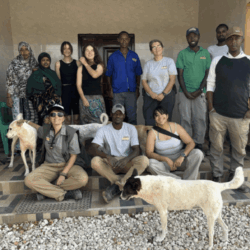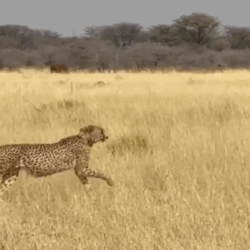The Cheetah Inner Ear is Built to Handle Speed
-

- by Meredith Hanel April 26, 2019

When we think of cheetah adaptations, we think of a body built for speed: slim body, long legs and a flexible spine that allows them to extend their stride. With cheetahs reaching speeds as fast as 110 km/hr, speed could be a liability if it wasn’t for special adaptations that allow them to handle that speed. Some adaptations include a tail that acts as a rudder and counter balance, foot pads and claws that grip like treads and cleats. The inner ear of the cheetah also helps it keep its balance. Chasing prey requires quick changes in direction and the inner ear balance system help cheetahs keep their head stable and their eyes focused on the prey.
The inner ear balance system, also called the vestibular system, contains three semicircular canals that contain sensory hair cells that detect head movement by sensing fluid movement in the canals. Each canal is positioned at a certain angle to specialize in detecting motion up and down, side-to-side, or side tilting. The inner ear communicates with the brain guiding the eyes and muscles to maintain posture and stabilize gaze. The vestibular system keeps us balanced and allow us to see objects clearly even when we are moving.
Cheetahs are different from all other large cat species alive today in that their vestibular system has a larger volume and two of their semicircular canals are longer. By analysing the skulls of extinct cheetahs of the species Acinonyx pardinensis which lived about 126,000 years ago, researchers found that the adaptation was not present in these ancestors from the Pleistocene period, suggesting this adaptation is recent. Scientists hypothesize that competition with other predators like pantherines and sabretooth cats likely pushed cheetahs to evolve both slender bones and a sensitive inner ear to allow them to hunt at such high-speed.
The inner ear is one of the best-preserved anatomical systems in the fossil record and provides insight into the ecological habits. While the inner ear itself is soft tissue, the bony labyrinth that surrounds the inner ear is the part that is preserved and can be used to measure the shape and dimensions of the organ it surrounded when the animal was alive. In the cheetah inner ear study, skulls from museum collections are micro-CT scanned and computer 3D reconstructions were generated.
The inner ear of a preserved specimen can give scientists clues about the animal’s locomotion and differences have recently been correlated to the different carnivore hunting styles of ambush versus pursuit. In primates a larger semicircular canal size is associated with more acrobatic species. Cheetahs have evolved a body that can accelerate faster than a Ferrari and an inner ear that helps them manoeuvre like a seasoned race car driver.
References
About the Cheetah. Cheetah Conservation Fund
Cheetahs’ inner ear is one of a kind, vital to high-speed hunting. (2018, February 02).
Ekdale, E. G. (2013, June 21). Comparative Anatomy of the Bony Labyrinth (Inner Ear) of Placental Mammals.
Grohé, C., Lee, B., & Flynn, J. J. (2018, February 02). Recent inner ear specialization for high-speed hunting in cheetahs.
How does our sense of balance work? (2017, September 07).
How does the balance system work?
Schwab, J. A., Kriwet, J., Weber, G. W., & Pfaff, C. (2019, January 11). Carnivoran hunting style and phylogeny reflected in bony labyrinth morphometry.
Spoor, F., Garland, T., Krovitz, G., Ryan, T. M., Silcox, M. T., & Walker, A. (2007, June 26). The primate semicircular canal system and locomotion.
Related Reading
-
November 23, 2025
Canadian Veterinarian Reunites With Rescued Cheetahs – Somaliland



